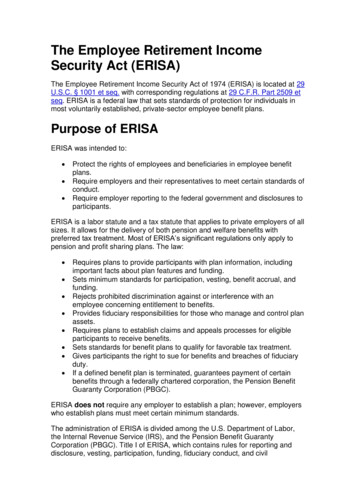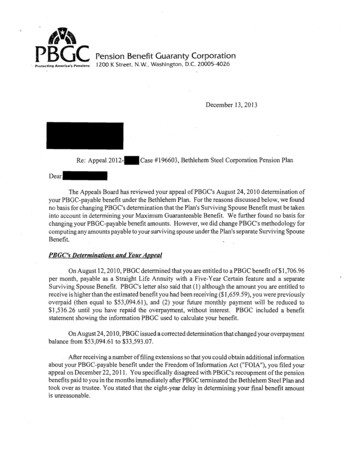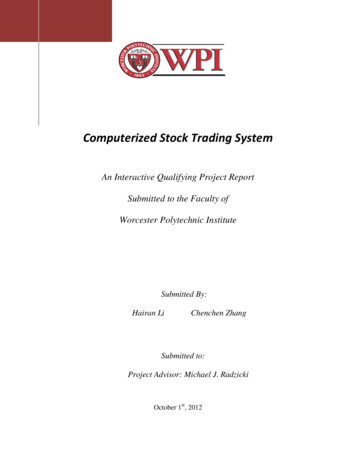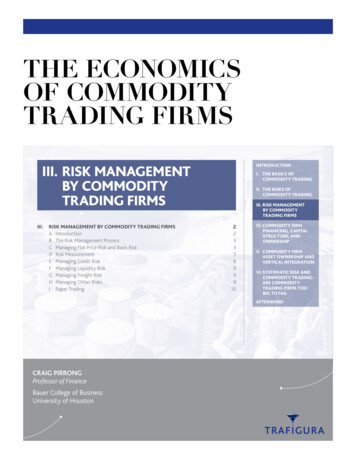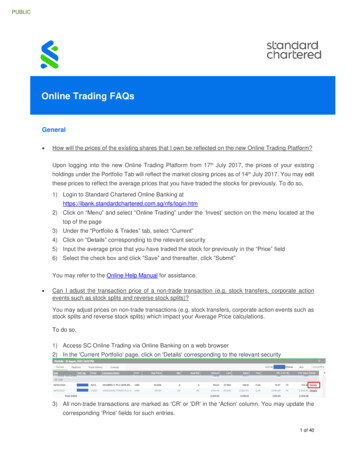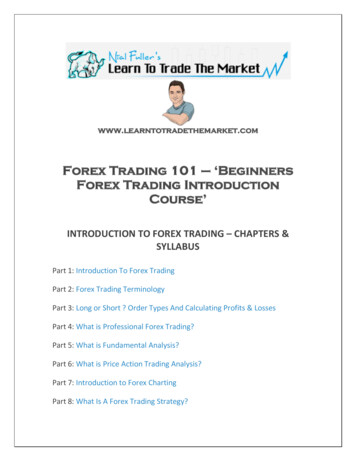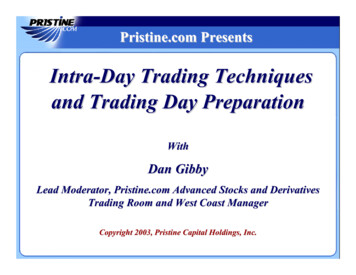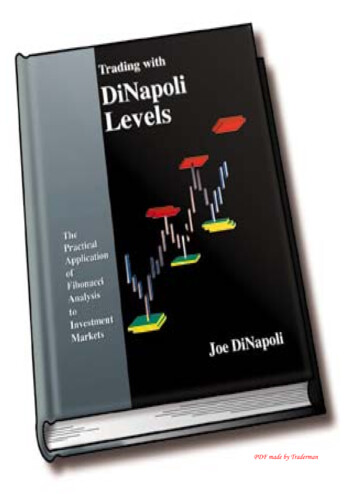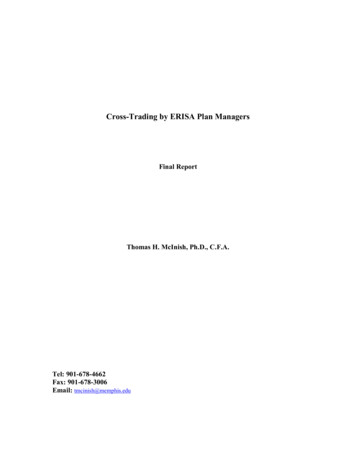
Transcription
Cross-Trading by ERISA Plan ManagersFinal ReportThomas H. McInish, Ph.D., C.F.A.Tel: 901-678-4662Fax: 901-678-3006Email: tmcinish@memphis.edu
Cross-Trading by ERISA Plan ManagersExecutive SummaryERISA prohibits cross trades, the exchange of assets between two accountswithout going through a public market. There have been numerous exemption requestsmotivated by a desire to reduce transaction costs. Mutual funds are permitted to crosstrade under Rule 17a-7. Opportunities for cross trades arise when some funds within agroup have cash inflows and others have cash outflows and due to differences of opinionamong managers for a given mutual fund group about the desirability of holdingparticular assets. Cross trades represent an economically significant source of savings formutual funds.With a view toward identifying insights relevant to cross-trading, this studyreviews the academic literature dealing with the way financial markets are organized andhow this organization affects transaction costs, dealer quotes and prices, and other marketcharacteristics. Transaction costs include direct costs such as commissions and indirectcosts such as the bid-ask spread, which covers order processing costs (the normalexpenses of providing liquidity) and asymmetric information costs (dealer losses toinformed traders). Additional indirect costs are market impact costs, delay costs, and theopportunity costs of missing a trade. Transaction costs typically range from one to fourpercent, depending on a number of factors such as the type of asset (equities, debt,derivatives, and currencies), daily trading volume in the asset, the size of the order,market conditions (recent news, whether others are buying or selling), and the country inwhich the asset is traded. Because investment managers often have one- or two-year
investment horizons, transaction costs are of sufficient size to be a significant drag onperformance.Dealer quotes reflect asymmetric information costs and trade size. Trade pricesexhibit regularities, including U-shaped patterns in returns, volume, variability of returns,and bid-ask spreads. There are other systematic features of trading such as the tendencyof the last trade of the day to be on the ask. Further, buys and sells do not have the samemarket impact.Without a market trade, it is impossible to know what price eachcounterparty would have paid or received.If both parties are equally motivated and seek to trade at the same time, it makessense to simply use the average of the bid and ask price as the cross trade price so that thebuyer and seller split the savings in commissions, market impact costs, delay costs, andopportunity costs.But if one party typically uses patient trading strategies or isaccommodating the counterparty, determination of a fair crossing price is difficult.Consider a manager of two ERISA plans, one of which needs to raise funds to payparticipants and plans to sell an illiquid security. The quoted market price is consideredlow. In fact the price represents such a “good deal” that the ERISA manager would liketo purchase the security in a second ERISA plan. The second plan may not havesufficient cash, but can sell very marketable securities to raise the needed funds. In thiscase, the second fund incurs extra costs to purchase the securities and is motivated tomake this investment only because obtaining these securities at such a good price willenhance the return of the fund. In this case the average of the quoted bid and ask in themarket would not represent a fair price for the second fund. Instead, the second fundshould probably receive the entire benefit of the “good deal.”
If the goal is to minimize risk, cross trading should be prohibited. In a costbenefit context, steps can be taken to reduce risk of abuse including limiting cross tradingto large plans and requiring a written plans and monitoring. This would permit plansreceiving an exemption to benefit from the savings available from cross trading.
Cross-Trading by ERISA Plan ManagersAbstractERISA prohibits cross trades, the exchange of assets between two accountswithout going through a public market. There have been numerous exemption requestsmotivated by a desire to reduce transaction costs (typically one to four percent). Mutualfund cross trades under Rule 17a-7 achieve economically significant savings.Transaction costs comprise commissions, market impact, and opportunity costs ofmissed trades. Further, round trip trades incur a bid-ask spread, which covers orderprocessing costs (the normal expenses of providing liquidity) and asymmetricinformation costs (dealer losses to informed traders). Dealer quotes reflect asymmetricinformation costs and trade size. Trade prices exhibit regularities, including U-shapedpatterns in returns and volume. Without a market trade, it is impossible to know whatprice each counterparty would have paid/received.If both parties are equally motivated and seek to trade at the same time, it makessense to cross at the spread midpoint. But if one party typically uses patient tradingstrategies or is accommodating the counterparty, determination of a fair crossing price isdifficult. If the goal is to minimize risk, cross trading should be prohibited. In a costbenefit context, steps such as having written implementation plans and strong monitoringcan reduce risk of abuse.
Cross-Trading by ERISA Plan Managers1. IntroductionThis study reviews the academic literature dealing with market microstructure1with a view to shedding light on the benefits and costs of cross trading. 2 Cross-trades areprohibited by ERISA unless they are consummated pursuant to an exemption. There havebeen numerous requests for exemptions to allow cross trading under specificcircumstances. A principal motivation for these exemption requests is that trading costsare substantial. The costs of trading vary across types of financial products such asequities, debt, derivatives, and currencies and also from country to country. Tradingcosts include direct costs such as commissions and taxes and indirect costs such as thebid-ask spread,3 market impact costs, delay costs, and the opportunity costs of missing atrade. Trading costs can amount to four percent and more of the amount of moneyinvolved. Because both sides of a cross-trade avoid commissions and other transactioncosts, the benefits are clear and substantial.The Department of Labor (DOL) has identified a number of potential abuses thatmight result from cross trading.4 These concerns have focused on the types of securitiessubject to cross trading, the way cross-trading affects investment decision and the like.1Market microstructure is “the study of the way financial markets are organized and how this organizationaffects prices, risk, trading costs, and other market characteristics.” (McInish, 2000).2We define a cross-trade as the sale of an asset for one portfolio and the purchase of that same asset foranother portfolio where both portfolios are under the control of the same individual or firm.3The ask (bid) is the price at which a liquidity provider is willing to sell (buy) and the difference betweenthe ask and the bid is called the spread, an important cost of trading. On each round-trip trade (a purchaseand sale) investors expect to pay a spread and suppliers of immediacy expect to earn a spread.4These include: providing artificial liquidity to favored accounts, allocating cross-trade opportunities tofavored accounts, and allowing cross-trade opportunities to affect investment decision. Department ofLabor, Pension and Welfare Benefits Administration, (March 20) 1998, Federal Register (Volume 63,number 54).
Here, we extend these concerns to additional issues related to the behavior of markets andthe way that trading is conducted. A few of these concerns may be indicative. In themicrostructure literature, the initiator of a transaction is viewed as the demander ofliquidity and the counterparty as the supplier of liquidity.5 The demander of liquiditytypically compensates the supplier. Some investment strategies call for more urgentexecution of orders than others. Plans with less urgent needs may use patient tradingstrategies such as the use of limit orders rather than market orders.6 By becomingsuppliers of liquidity rather than demanders, patient traders may dramatically reducetransaction costs. By becoming a party to a cross trade, a plan foregoes the possibility ofusing patient trading strategies.On the other hand, investment managers already face difficult allocation decisionsthat may involve ERISA plans. Wagner (2000) discusses the problems facing managersin executing orders when the manager has a fiduciary duty to multiple clients, possiblyincluding multiple ERISA plans. In accumulating positions in the same asset for multipleaccounts, all accounts that trade on the same day typically get the same average price.However, rather than allowing investment managers a free hand in selecting brokers toexecute trades, some clients require the investment manager to direct trades to aparticular broker. The investment manager selects a broker to execute the non-directedorders. In this case it may not be fair for non-directing customers to suffer or benefitform directed orders. Separation of trade execution channels in this way requires some5The microstructure literature often considers two types of traders. Informed traders’ orders are motivatedby information about the value of assets. On the other hand, liquidity motivated traders do not tradebecause of information. A mutual fund might have an inflow of cash that must be invested. The termsnoise trader, uninformed trader, and liquidity trader are synonymous. Noise traders may include traderswho think the have information, but do not.6Order types are described in appendix 1.2
orders to go first with subsequent orders likely experiencing greater market impact costsand opportunity costs due to execution failures. Most managers require trades withconstraints to go last.7One group seeking permission to cross trade between ERISA plans are in-houseasset managers (INHAMS8).INHAMs are required to be Registered InvestmentAdvisors and, therefore are subject to SEC inspections. Trading, including cross-trading,is a focus of these inspections (see appendix 2). It is unlikely that SEC inspectors wouldnote or comment on DOL regulations in their inspection reports if these differed fromSEC requirements. But the fact that these INHAMS are subject to the inspectionsindicates that have experience with maintaining the types of records that would be usefulto plan fiduciaries in evaluating cross trading.92. Mutual fundsMutual funds can cross trade under Rule 17a-7 of the Investment Company Act of1940.10 Many mutual fund groups take advantage of this rule to effect cross trades, butsome benefit to a greater extent than others. Many cross-trades are liquidity motivated.Events that trigger a cross-trade may arise from the normal inflow and outflow of fund7Wagner (2000).8The INHAM concept is described in PTE 96-23 60 Fed. Reg. 15597 (Mar. 24, 1995).9The types of records that might be useful are described in the letter of Mr. Ivan Strasfeld to the U.S.Department of Labor dated July 10, 2000. These include the trade date, the name of the issuer/security, thetype of transaction, the principal amount of number of shares; the price and the basis for the price, the highand low price for the security on the trade date, and a certification regarding compliance with the firm’sprocedures.10Rule 17a-7 -- Exemption of Certain Purchase or Sale Transactions Between an Investment Company andCertain Affiliated Persons Thereof, Investment Company Act of 1940.3
assets. However the initiation and termination of funds within a group may increase theopportunities for cross trades.Consideration of several actual mutual fund groups may be useful. Longleaffunds manage more than 4.5 billion of assets and had more than 700 million of securitypurchases in 2001. Yet, Longleaf funds typically effect only a few cross trades each year.However, the closing of one of Longleaf’s four funds in 2001 allowed for the increaseduse of cross trading.11 Longleaf’s opportunities to cross trade are limited by the fact thatall of its funds are value funds that seek to acquire securities that are assessed to beundervalued.A more important source of cross trading opportunities arises fromopportunities to trade among different managers within a fund group. If a fund group hasdifferent types of managers or managers with differing opinions, there are increasedopportunities for cross trading. American Century has more than 85 billion undermanagement. Cross trading opportunities have resulted from a shift of investors’ assetsfrom growth to value managers within the group. The American Century Small CapValue Fund’s assets grew from 225 million at the end of 2001 to 1,286 million at themiddle of June 2002, a growth of 1,061 million. Assuming that 1% of this asset growthwas accomplished through cross trades and that a cross trade saves 1% of the transactionvalue round trip, the resulting savings are ( 1,061 million X 0.01 X 0.01) ) 106,100.1211The Longleaf funds operated four funds during 2001 including the Partners, Small-Cap and Realty funds.The Realty fund was closed. The Longleaf Partners Funds annual report at December 31, 2001 states:“Purchases in the Partners and Small-Cap Fund include securities purchases from the Realty Fund inconjunction with its liquidation. The securities were purchased from the Realty Fund at the last sales priceon the security’s primary exchange, without brokerage commission in accord with procedures previouslyadopted by the Boards of Trustees of the Funds pursuant to Rule 17a-7 of the investment Company Act of1940.“12One half of the savings accrues to the Small Cap fund and one-half to the fund with the cash outflow.4
As the amount of assets under management increases, the potential savings fromcross trading grows at an even faster rate. One reason for this is that larger funds trade inlarger blocks, which have greater market impact. Another reason is that larger fundshave more managers leading to more disagreements as to whether a given stock should beincluded in a portfolio. Fidelity Investments manages more than 150 mutual funds.Conversations with industry executives indicate that perhaps 8% to 10% of equity tradesare cross trades at Fidelity. Fidelity has an ERISA exemption, but this exemption is not asignificant factor in Fidelity cross trades.13 Consider just one Fidelity Fund, the FidelityAggressive Growth Fund, which had assets of 5,324 million and a turnover rate of 118%in 2001.14 Assume that all trades are equity trades, that cross trades save 1% round trip,and that 8% of trades are cross trades. Then the savings for this fund in 2001 due to crosstrades was ( 5,324 million X 1.18 X 0.08 X 0.01 ) 5.026 million, not counting anysavings due to purchases made as a result of fund growth. Even though the FidelityMagellan Fund had a turnover rate of only 15%, because its assets total almost 72billion, the savings from cross trades would likely have more than ( 72,000 million X0.15 X 0.08 X 0.01 ) 8.6 million.Clearly, cross trades represent economicallysignificant sums for Fidelity Investments.These considerations lead to the following observations that are applicable toERISA plans. The larger the ERISA plan the greater the potential savings from cross13PTE 94-43.14For a mutual fund, the portfolio turnover rate is an annualized rate found by dividing the lesser ofpurchases or sales by the average of portfolio assets. Suppose that a fund is growing so that purchases ofassets are greater than sales. In this case, a turnover rate of 1.0 indicates that sales of assets equaledaverage fund assets and purchases of assets equaled sales of assets plus any purchases of assets due to fundgrowth.5
trading and the potential savings grows at a much faster rate than the rate of asset growth.The main considerations that lead to this result are:1. Market impact and delay costs. Larger investment size leads to greater marketimpact costs. If 50,000 shares are traded each day, an order for 20,00 shares cantypically be executed quickly with little market impact while an order for 200,000shares will take more time to execute and incur more market impact. An order for400,000 shares is typically more than twice as difficult and takes more than twiceas long to execute as an order for 200,000 shares.2. Larger funds may involve more ERISA plans. The likelihood that there will beinflows for one plan and outflows from another at the same time is much greaterif there are five plans than if there are only two plans.3. Larger funds have more investment managers.Investment managers maydisagree about the merits of a particular investment. The greater the number ofinvestment managers the greater the likelihood that one manager will want to buya security that another manager is selling. This observation is most applicable toplans that employ multiple external investment managers.3. Transactions costsTransactions costs are all of the costs associated with the management ofinvestments, including the time involved in making investment decisions.15 Transactioncosts are classified as explicit or implicit. Explicit costs are itemized separately and paidfor like any other expenses. The most common explicit costs are commissions and15For additional information see Schwartz and Whitcomb (1988).6
transfer taxes and fees. The most common implicit transaction costs are the bid-askspread, market impact costs, delay, and opportunity costs. Table 1 provides an estimateof each of these costs for equities.16 Note that commissions are the smallest componentof execution costs. Delay costs are the largest cost. Market impact costs are alsosubstantial totaling 50% more than commissions. The costs of executing the averagesmall cap order are more than four times as high as that of the average large cap order.17A study of 31 stocks whose weighting in the Toronto Stock Exchange 300 index waschanged due to a redefinition of public float showed that the price impact of the changeon these 31 stocks was 2.34 percent.18 Because of market impact costs, it is common forinstitutions to break up large orders for execution. Define a trade package as orders onthe same side of the market by a single investment manager. One study of 37 largeinstitutions found that more than one-half of the dollar value of executed trade packagesrequired four or more days for completion. This finding provides strong evidence that16Taking a different approach, Hasbrouck and Schwartz (1988) reason that execution costs due to bid-askbounce (the movement of stock prices between the bid and the ask), market impact, and the like,temporarily push trading prices away from their true value. Hence, comparison of volatility over differentperiods can be used to investigate the impact of transaction costs. These authors calculate the ratio of thevariance of 12-hour returns to 24 times the variance of half-hour returns. Because these intervals cover thesame calendar period, we know that the actual volatility is the same over these two measurement intervals.Therefore, the value of the ratio should be 1.0. Any temporary deviations provide a measure of executioncosts. Using this methodology these authors report average execution costs of 0.148% of the transactionsamount for NYSE-listed stocks. The comparable costs reported by Hasbrouck and Schwartz for AmericanStock Exchange and more liquid NASDAQ stocks are 0.123% and 0.438%, respectively. If the assumptionthat the entire difference in the variance ratios is due to transaction costs does not hold, the Hasbrouck andSchwartz measure will overestimate execution costs. Stabilization activities of the specialist, the presenceof limit orders, or the sequential arrival of information causing price adjustment delays might also affectshort-term price volatility.17In this example large (small) cap (capitalization) is more (less) than one billion dollars.18Kaul, Mehrotra and Morck (2000).7
many institutional orders could not be executed without substantial market impact.19There is evidence that execution costs for institutions have increased recently.20Table 2 compares equity execution costs for seven countries. In every countrycommissions represent only a fraction of total execution costs. Trading costs can also belarge for debt instruments. One study reports that trading costs for bonds are about 0.27for each 100 of face value.21 Small institutions pay more than large institutions andsmall trades cost more than large trades.22In the next two parts of this section, direct and indirect transaction costs areconsidered, in turn. Then, issues related to transaction costs—price improvement, ECNs,patient trading, and monitoring transactions costs—are considered.Implicit transaction costs: The bid-ask spreadThe bid-ask spread was the focus of much of the early work dealing withtransaction costs and the earliest investigations of spreads focused on order processingcosts. These include the costs of the dealer's time, paper-work costs, transfer taxes, andother expenses incurred by the dealer in providing immediacy. In the process of makinga market the dealer may have money invested in the asset, incurring opportunity costs19Chan and Lakonishok (1995).20On June 24, 2001, the New York Stock Exchange lowered its minimum price increment or tick size from 0.125 to 0.0625. Examining institutional orders, this change decreased total execution costs for smallorders of less than 1,000 shares, did not change execution costs for orders of from 1,000 shares to 9,999shares, and increased costs for order of more than 10,000 shares. Institutional orders of more than 100,000shares cost one-third more to execute (Jones and Lipson, 2001). These authors measure execution costs asthe proportional difference between the volume-weighted average execution price of trades executed as partof the order and the price prevailing at the time the order was released to the trading desk.21Schultz (2001).22Schultz (2001).8
that contribute to order processing costs.Another cost of providing immediacy isinventory holding costs, dealer losses resulting from a positive or negative inventoryposition.23More recently, a third cost incurred by dealers who provide immediacy hasreceived attention, namely, asymmetric information costs.24 Some investors are likelybetter informed than the dealer. When these informed investors buy from the dealer,subsequently, prices are likely to rise. And when informed investors sell to the dealer,subsequently, prices are likely to decline. Therefore, in dealing with informed investorsthe dealer is buying just before price decreases and selling just before price increases.25A buy transaction arriving after a long time interval has a lower price impact than a buytransaction arriving right after a previous buy. Because informed traders typically seek totrade quickly before their information becomes generally known, liquidity suppliers infera higher likelihood of traders being informed if the trades are close together.2623Inventory holding costs are the costs incurred or anticipated by a dealer as a result of inventory positionsacquired in the process of market making. An example of the inventory holding cost model is provided byHo and Stoll (1981) who propose that after a dealer purchase bid prices are lowered to discourageadditional sales and ask prices are also lower to encourage purchases from the dealer. Thus, the new bidand ask prices must reflect prices that make the dealer indifferent between a transaction at the bid and atransaction at the ask.24Asymmetric information costs are the costs incurred or anticipated by a dealer as a result of trading withcounterparties who are motivated by the possession of superior insight into the appropriate equilibriumprice of the asset. Of course, the loss to the less knowledgeable party is the gain to the party with superiorinsight. A trader with knowledge that current prices are not at true value would is motivated to tradeimmediately rather than provide liquidity to others.25If this were not the case the market maker’s counterparties would not truly be informed. For examples ofasymmetric information models see Copeland and Galai (1983) and Glosten and Milgrom (1985).26Dufour and Engle (2000). There is evidence that order processing costs have little intra- or inter-dayvariation, but adverse selection costs are high at the beginning and end of the trading day relative to themiddle of the day. Adverse selection costs are also higher on Mondays than on other days of the week foractively traded firms.9
Glosten and Harris (1988), among others, have developed a methodology forestimating order processing costs and asymmetric information costs. Inventory holdingscosts, which are small, are not estimated separately, but are included in order processingcosts. For a sample of 856 equities traded on the New York Stock Exchange in 1999, thecosts as a percentage of the spread are:order process costs, 61.1%; asymmetricinformation costs, 38.9%.27Implicit transaction costs: Market impact costsThe execution of an order has the potential to move the market price. Here we aretalking about more than the change from the bid to the ask. Market impact involvesmoving the bid and/or ask either temporarily (in response to liquidity motivated trades) orpermanently (in response to information-based trades). Suppose that a market has sellerswilling to sell 5,000 shares at 50 and 5,500 shares at 50.10. An order to buy more than5,000 shares will exhaust the supply at 50 and if immediate execution is required willnecessitate executing part of the order at 50.10. Hence, this order will have marketimpact. Market impact is a cost associated with implementing an investment decision.Empirical evidence shows that for a given price change, the size of the associated trade islarger for sells than for buys. An early study reports that a decline of 0.125 is associatedwith a trade size of 451 shares while an increase of 0.125 is associated with a trade sizeof 427 shares.28 Hence, if the market impact of buys and sells differs, determining a27Van Ness, Van Ness, and Warr (2001).28Wood, McInish, and Ord (1985).10
cross-trade price by, say, taking the midpoint of the bid and ask, may be unfair to one ofthe parties.It may take several days to execute an order. There is a trade off between marketimpact costs and delay costs. Table 1 shows that delay costs are much larger thancommissions and, in fact, are almost 60% larger than commissions and market impactcombined (0.60/0.38 1.58).Opportunity costs result when the order cannot becompleted due to market price movements or other factors. Table 1 shows that for onesample the opportunity costs of the ten percent of trades not completed were twentypercent greater than commissions.Block tradesA block trade is commonly defined as a trade of 10,000 shares or more.According to one study, the price impact of block trades on Nasdaq is -0.55% for salesand 0.53% for purchases. Comparable figures for the NYSE are –0.48% for sales and0.46% for purchases.29The relationship between trade size and transaction cost is not as simple as largertrades cost more. In fact, one study reports “no evidence that larger trades are associatedwith higher indirect execution costs.”30 Larger trades have greater impact, but therelationship between trade size and market impact is not linear in trade size.31 Theinformation content of a block trade increases with trade size using earnings forecast29LaPlante and Muscarella (1997).30Block, French, and McInish (1994).31Koski and Michaely (2000).11
errors as a proxy for information asymmetry.32 Large trades have a greater price impactduring times when asymmetric information is greatest.33Buys and sells have different market impact. A price change of 1/4 is associatedwith an average trade size of more than 1,400 for a price increase and more than 1,700shares for a price decrease.34 Researchers have found that block purchases have a largerpermanent price impact than block sales.35 Similar results are reported for institutionaltrades.36 Prices go up on purchases and down on sales, but the sale prices quickly revertto their pre-trade price while the increased prices due to purchases are permanent.37 Theeffects of transactions and cumulative order activity on the price schedule increase as theaverage trading volume decreases.38The probability of information based trading is lower in high volume stocks.High volume stocks tend to have a higher incidence of information events than lowvolume stocks, leading to a higher arrival rate of informed traders. But the effects of thehigher arrival rate of informed traders are more than offset by an even higher rate ofarrival of liquidity traders.39 The majority of trades are small, but most of the cumulativestock-price change is due to medium-sized orders. Informed traders would prefer to trade32Seppi (1992).33Koski and Michaely (2000).34Wood, McInish and Ord (1985).35Kraus and Stoll (1972) and Keim and Madhavan (1996).36Chan and Lakonishok (1993).37Chan and Lakonishok (1993).38Kavajecz and Odders-White (2001).39Easley, Kiefer, O’Hara, and Paperman (1996).12
in moderate size because a very large order attracts attention and a small order does notallow the accumulation of enough shares.40 The source of these medium-sized trades thatgenerate most of the cumulative returns is institutions.41An upstairs market is a market in which larger orders are given special handling.On the NYSE brokers in the upstairs market can solicit counterparty orders, a practice notpermitted on the trading floor. On the Toronto Stock Exchange most of the orders thatare executed in the upstairs market are liquidity motivated so that they
Cross-Trading by ERISA Plan Managers. Final Report . Thomas H. McInish, Ph.D., C.F.A. Tel: 901-678-4662 . . the second fund incurs extra costs to purchase the securities and is motivated to . 8The INHAM concept is described in PTE 96-23 60 Fed. Reg. 15597 (Mar. 24, .
